Flowering Bonsai
Flowering bonsai come in various types and make a good, colourful addition to your bonsai collection.
If you want to start from scratch there are several different varieties to choose from including azalea, crape myrtle, and dogwood trees.
Some require more attention than others with regards to watering and fertilizing. Be sure to do your research before purchasing one as they can take up quite a bit of time each day to care for them properly.
So what type of flowering bonai would you like?
Types of flowering bonsai tree varieties
Here are some types of bonsai trees with flowers
1) Azalea (red or pink depending on the type):

[Photo Credit: Fine Art America]
These flowering bonsai trees come in red and pink. The azalea flowering bonsai is suitable for those who want to try growing a bonsai tree but don’t have much room.
They can tolerate more sunlight than other varieties. They are easy to care for and can be pruned often. Be sure to trim them back in the winter to keep them small enough so you can fit other plants around it later on.
2) Crape Myrtle (pink or purple flowers):
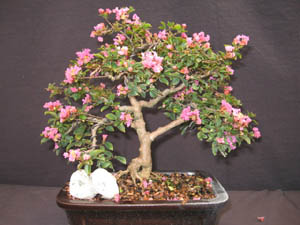
These come in either pink or purple.
The main difference between these is the color of their flowers. They have delicate white flowers and are recommended for indoor use with proper sunlight.
Though they love to get a lot of attention, they need a rest period once in awhile. These need less water than other varieties so you can skip watering two out of five days instead of three or four out of seven.
3) Dogwood (white or pink flowers):
These flowering bonsai trees are bigger than other varieties, but come in a variety of colors and can tolerate low light conditions. They need to be watered every day and the soil should never dry out completely or they will die.
4) Flowering bonsai white flowers:
These have delicate white flowers that blossom in the spring and are prized for their ability to grow well.
They need a sunny window with moderate humidity levels and require watering once every three or four days, but do not allow them to dry out completely.
5) Flowering bonsai cherry (red tinged flowers):
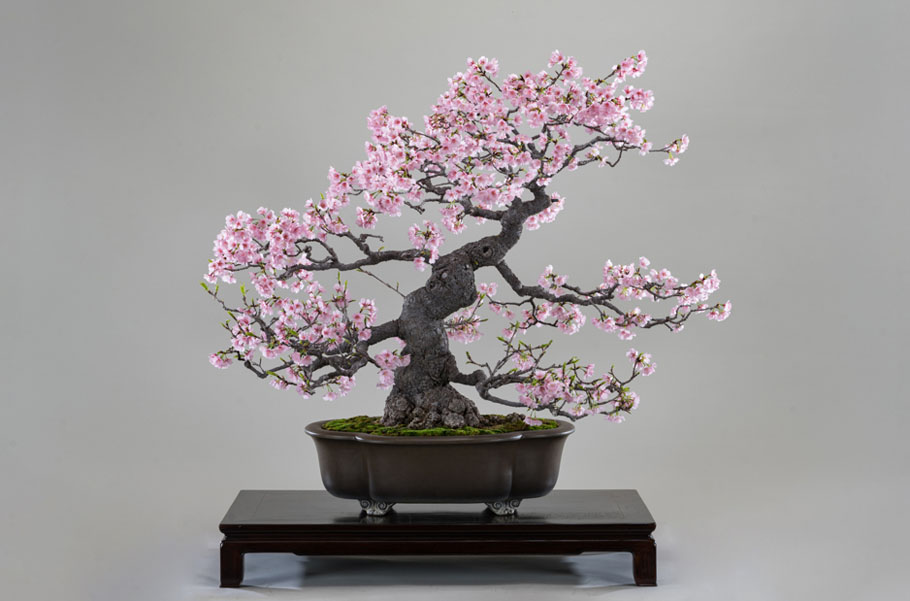
Cherries are prized for their leaves and flowers, which can be used in floral arrangements. They grow well in full sunlight and require watering once a day when the soil is dry to the touch.
Since they are delicate, the pruning should be done during autumn or winter months.
6) Flowering bonsai juniper:
These flowering bonsai trees are suitable for the beginner because they can tolerate low light and other conditions. They naturally grow in rocky environments and need to be kept dry.
They do not need to be pruned often but can be shaped by pinching or by removing small side branches depending on how you want your bonsai to look.
7) Flowering maple (red or yellow flowers):
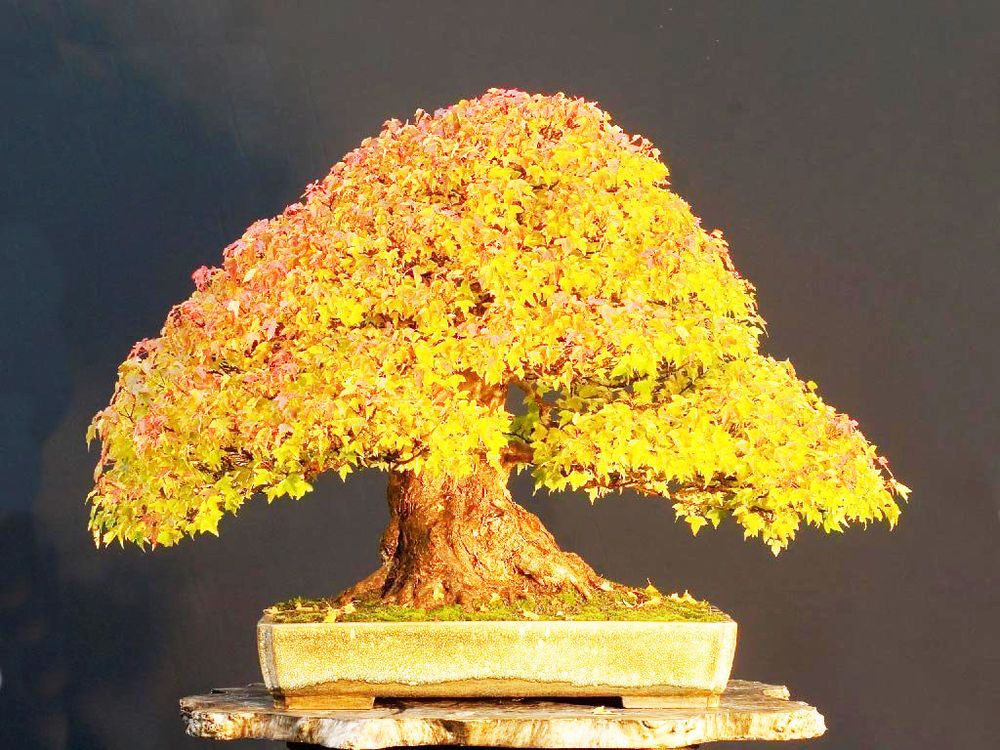
These flowering bonsai trees have delicate leaves and are good for the beginner. They get along well with others around them in pots and can grow in almost any conditions, including indoors.
8) Flowering bonsai elm:
Bloodgood Bonsai recommend this variety because they are sturdy plants that need very little care. They grow well in sunlight or low light and can tolerate most conditions.
9) Flowering purple larch:
These trees have a fascinating history. The oldest flowering bonsai was found beneath an altar that was built in the year 794 AD! They do need full sunlight but are great trees for the beginner to grow.
10) Flowering bonsai (yellow flowers):
These trees have delicate yellow or white flowers and are easy to prune and shape. They do not need much care but should be kept in a sunny area with moderate temperatures and watered once every three to four days.
11) Toyo nishiki flowering quince bonsai:

These flowering bonsai trees are prized for their leaves, which have a delicate pattern. The flowers tend to be small and white.
12) Fuschia Flowering Bonsai :
These have long slender pink or red flowers that bloom in the spring. They need moderate sunlight and water every three to four days when their soil is dry.
13) Flowering Chinese Banyan:
These flowering bonsai trees are prized for their foliage and flowers, both of which can be used in floral arrangements.
Their leaves look like they have been through an earthquake and this variety of bonsai history goes back many centuries! They need medium sunlight and moderate humidity.
So now that we’ve highlighted a few floweing bonsai, can they be grown from seeds?
Growing flowering bonsai from seeds
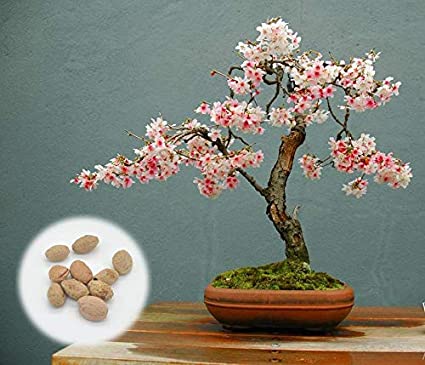
Growing your flowering bonsai tree from seeds is not an easy task, but it is possible.
Before planting the seeds, sterilize them to remove bacteria and fungi by putting them in boiling water for 10 minutes.
Once they are cool enough to handle, plant one seed per pot with a half inch of soil over the top of the seeds.
Keep your bonsai tree in partial sunlight and keep the soil moist.
It will take a few weeks for the seeds to germinate but once they have sprouted, keep them in partial sunlight and keep watering them every day until they are an inch tall.
Once this has been achieved, transplant them into larger pots and plant several of these together.
Do flowering bonsai require more time?
Regardless of which type of flowering bonsai you choose, there are several tasks that need to be tended to on a daily basis.
The first is watering. Make sure the soil of your flowering bonsai tree does not dry out and water it every day so that if the weather permits it will get watered two or three times a day.
If you have other plants in your home that need watering, make sure you water them before watering your bonsai tree.
It is very important that once it has been watered that the soil should be allowed to drain for a few minutes so it can retain as much water as possible.
Flowering bonsai trees daily tasks
Another task that needs doing daily is pruning and fertilizing. The flowering bonsai tree needs to be trimmed and fertilized twice a month during the growing season.
Make sure when pruning that you are pruning back branches that are not needed or old fruit.
The young, fresh growth is needed for healthy new flower production.
If your flowering bonsai tree is indoors you need to make sure it gets as much sunlight as possible.
If you have an outdoors flowering bonsai tree, it should get at least two hours of sunlight daily.
Do flowering bonsai require more water?
Yes, because flowering bonsai trees will lose most of their leaves during the winter months.
Follow the same watering regime as above:
- Water every day so that it is watered two or three times a day if possible and make sure to allow it to drain for a few minutes after you have watered it so there is no standing water left.
Do flowering bonsai require more sunlight?
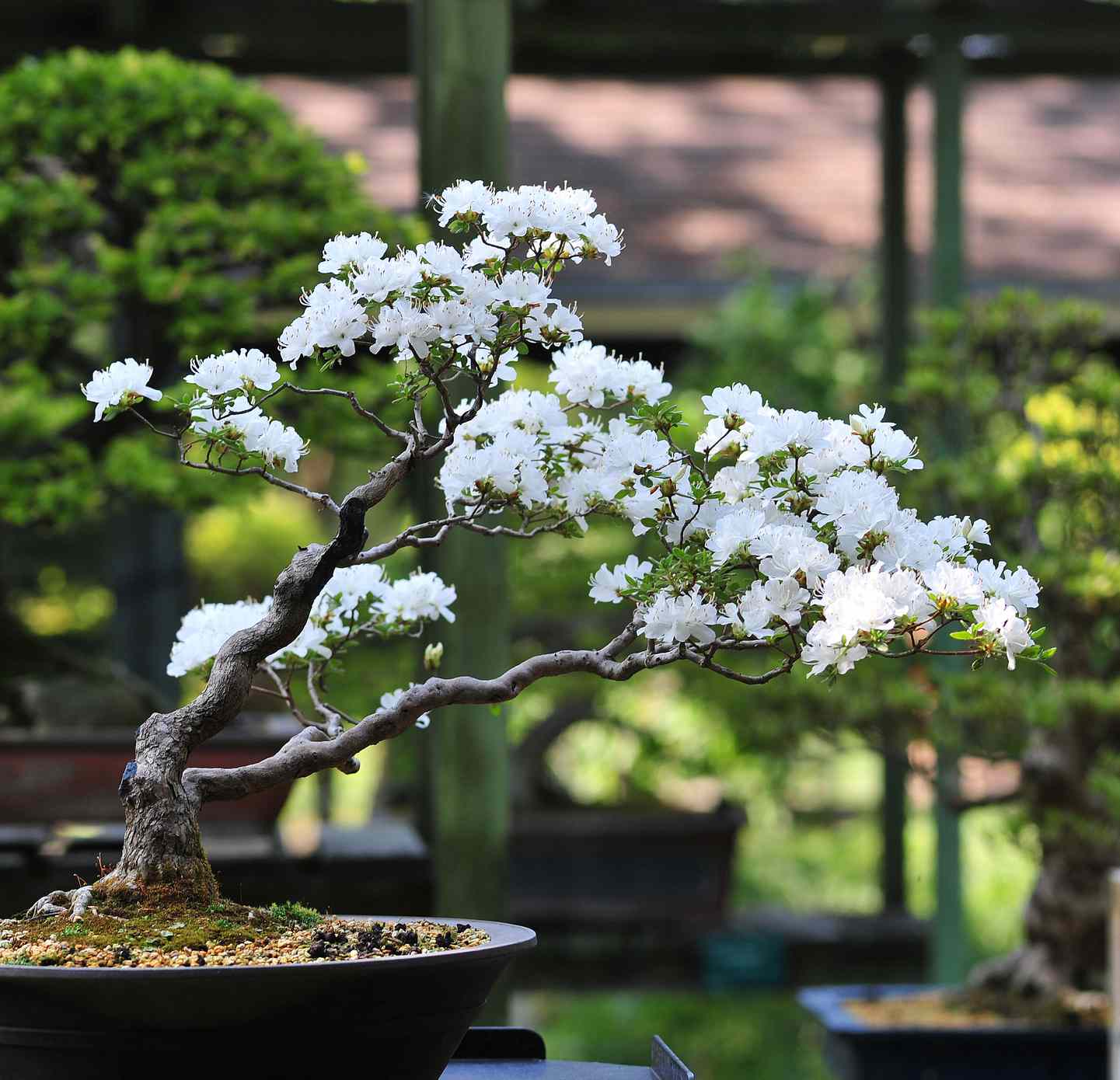
Yes, because flowering bonsai trees will lose most of their leaves during the winter months.
They need to be placed in a south-facing window where they get at least two hours of sunlight a day.
It is also important that you keep your flowering bonsai tree out of direct sunlight as this can burn the leaves and turn them brown.
Do flowering bonsai require more fertilizer regularly?
Don’t neglect to fertilize flowering bonsai trees during their blooming period.
You should fertilize twice a month during the growing season so that their roots can grow strong. This will help your flowering bonsai tree produce better flowers.
Do flowering bonsai require better soil?
The type of soil a flowering bonsai tree is planted in will depend on the species of plant you have chosen.
If you are unsure, it is recommended that you ask your local gardening shop what is best for your flowering bonsai tree’s species.
The most important thing to do when choosing flower pot soil for your flowering bonsai tree is to make sure the soil drains well.
You should keep in mind that when it rains, your flowering bonsai tree will lose more water due to its limited amount of leaves, so good drainage is critical.
To achieve this, add some coarse river sand to your regular flower pot soil mixture before you plant your flowering bonsai tree. T
his way you will have better drainage and the soil will not become water logged and moldy.
Do flowering bonsai need to be pruned more often?
Flowering bonsai trees can produce flowers at the end of their branches, but similarly to fruit being produced on other flowering bonsai trees, this is not always the case.
If you are growing a flowering bonsai tree from cuttings, it is almost certain that they will produce flowers on their branches.
If your flowering bonsai tree is producing flowers on the end of its branches and looks messy, then you should prune them off to make sure your flowering bonsai tree is neat and tidy.
Do flowering bonsai need to be repotted more often?
Flowering bonsai trees will generally flower most in their first two years of growth, so it is best if you repot them before they begin flowering.
This way the soil can drain better when it rains and your flowering bonsai tree will be healthier.
Once your flowering bonsai tree has flowered for the first time, repot your flowering bonsai tree every two years and make sure you use a good quality flower pot soil mixed with some coarse river sand.
When you are pruning off dead flowers do not throw them away; instead save them so that you can use them as seeds for next year’s flowers.
How should flowering bonsai be stored throughout winter?
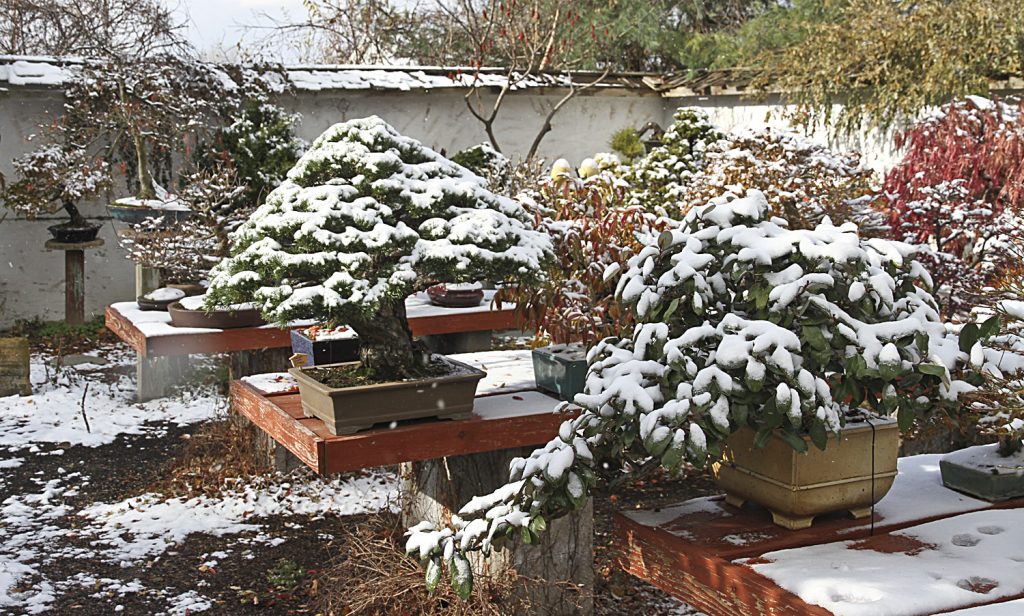
The general rule is that you should prune all of the leaves off your flowering bonsai tree and then store it in a cool, dark place to prevent it from losing too much water. Some people will wrap their flowering bonsai in a paper bag and then store them in their shed or garage.
Do flowering bonsai need to be kept inside for the winter?
Even if you live in an area where it snows regularly, your flowering bonsai trees will not die if they are stored outside.
During the summer months, they should be protected from extreme heat and the loss of moisture, but during winter months it is fine to leave your flowering bonsai tree outside.
You can prevent your flowering bonsai trees from losing too much water by wrapping them in a paper bag or newspaper before putting them in a shed or garage.
However you choose to keep them, make sure they are kept out of the sun and cold air so that they do not lose too much water.
Do flowering bonsai need to be protected from pests during winter?
Even though your flowering bonsai tree is dormant during winter months, it will still attract insects like bees, butterflies and moths.
If you see a lot of pests on your flowers or if the flowers are being eaten by pests, then make sure you put some insecticide powder on your flowering bonsai tree to protect it.
Do flowering bonsai need to be protected from extreme cold during winter?
Your flowering bonsai trees will go dormant during winter so they will not be able to withstand very low temperatures.
Make sure you protect your flowering bonsai tree from extreme cold to prevent it from losing too much water.
If there is a lot of snow on top of the ground, then you should remove it so that your flowering bonsai tree does not weigh down the branches as they are brittle and will snap under pressure.
If its windy where you are, then cover your flowering bonsai tree with a windbreak so that it does not blow away.
Do you keep your flowering bonsai indoors?
What methods do you use to protect them through the winter months? Feel free to leave a comment below this article and also subscribe to our RSS feed to keep up-to-date about our bonsai related articles.
Do flowering bonsai trees cost more?
There is a common myth that flowering bonsai trees cost more money than regular bonsai trees.
However, once you have looked after it for two or three years your flowering bonsai tree will actually start to produce its first flowers and this is when the price of your flowering bonsai tree will rise dramatically.
Where to buy a bonsai tree?
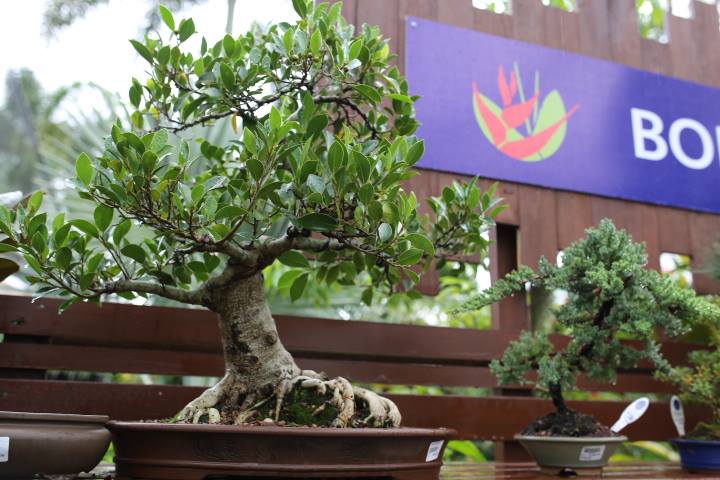
[Photo credit – Oxley Nursery Brisbane
If you are looking for a bonsai tree with flowers your local nursery would be your best choice.
Conclusion
One of the most versatile types of bonsai is flowering bonsai. These plants can be grown in a wide variety of climates and are ideal for those who have limited space or want to incorporate some color into their garden, as they flower throughout the year.
However, you may not know how to care for them properly or where to buy one! We’ve gathered all your questions about these beautiful pieces here so that you can get started with this new hobby ASAP without any worries.
